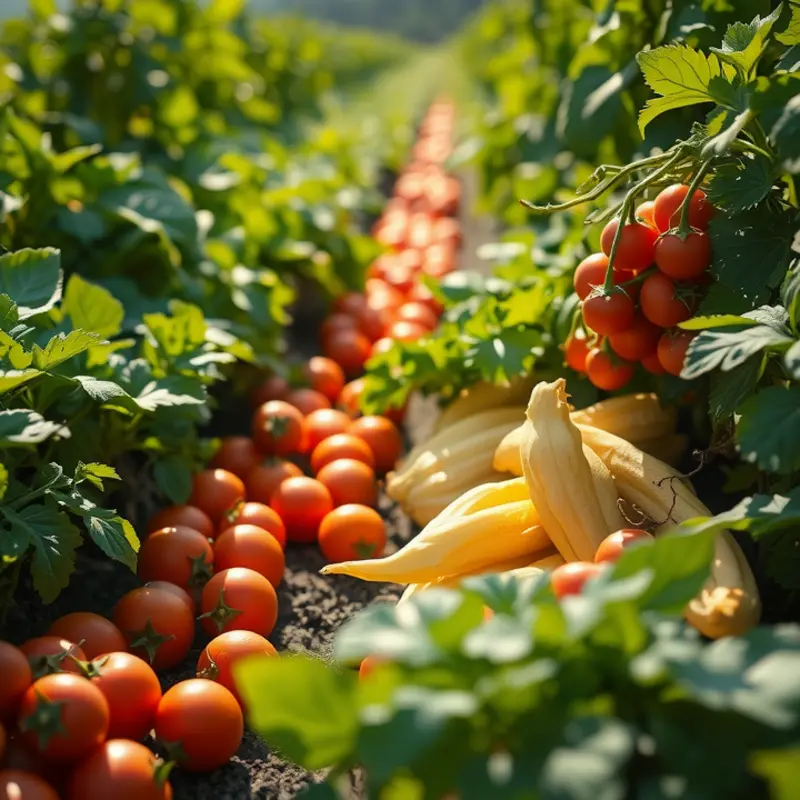Choosing green ingredients is more than a trend; it’s a commitment to the planet and future generations. By sourcing food that champions sustainability, we not only nourish our bodies but also support ethical farming practices and ecosystem health. This guide aims to empower individuals dedicated to making eco-friendly food choices by providing practical tips and resources for sourcing green ingredients responsibly, embracing the joy of conscious consumption.
The Importance of Sustainable Sourcing

Sourcing green ingredients is pivotal in fostering a healthier lifestyle and preserving the planet. Choosing to purchase locally grown, organic, and seasonal foods contributes significantly to environmental sustainability and enhances personal well-being.
Local Foods
One major advantage of locally sourced ingredients is the reduction of the carbon footprint. When ingredients travel from distant places, it results in emissions from transportation—contributing to pollution and climate change. By opting for local produce, we support regional farmers while ensuring fresher and often more nutritious food due to the reduced transit time. Moreover, embracing your local agricultural community can strengthen the economy and create job opportunities. For those interested in practical ways to make environmentally friendly choices at home, practices like eco-smart kitchen storage also contribute to a sustainable lifestyle.
Organic Foods
Organic farming emphasizes environmentally friendly agricultural practices. Organic foods are grown without synthetic pesticides or fertilizers, thereby safeguarding soil health and the surrounding ecosystem. The absence of chemical residues also means a lower risk of ingestion, which is beneficial for human health. Furthermore, organic agriculture often employs crop rotation and genetically diverse crops, which help maintain biodiversity and a balanced ecosystem.
Seasonal Eating
Seasonal eating is not only about enjoying fruits and vegetables when they taste their best, but it’s also a sustainable choice. When we eat with the seasons, we reduce the demand for out-of-season produce, which often requires energy-intensive storage methods. Seasonal foods are typically produced locally, minimizing the need for long-distance transportation. They also encourage a varied diet, which is beneficial for nutrition and microbiome diversity.
Ecological Balance and Personal Well-Being
By aligning our diets with sustainable practices, we help restore and maintain ecological balance. Regenerative approaches to farming can enhance soil health, increase biodiversity, and capture carbon emissions, fighting climate change. For individuals, engaging in sustainable sourcing can improve well-being through enhanced nutrition and reduced exposure to harmful chemicals. This holistic approach ensures that we not only nourish our bodies but also give back to nature, fostering a resilient ecosystem.
In conclusion, the choices we make regarding the sources of our food have wide-reaching impacts. By prioritizing sustainable sourcing, individuals can enjoy a harmonious relationship with both their health and the environment.
Practical Tips for Sourcing Green Ingredients

Finding eco-friendly ingredients starts with choosing fresh, seasonal produce. Local farmers’ markets are exceptional sources, offering ingredients that have traveled fewer miles to reach your plate. When exploring these markets, engage with the vendors. Ask about their farming practices to understand how they manage their environmental impact.
Community-supported agriculture (CSA) programs present another sustainable option. By subscribing to a CSA, you establish a direct relationship with local farms. This commitment supports the local economy and ensures your produce is fresh and seasonal. Research CSA programs in your area to find a scheme that aligns with your dietary needs and values.
For those who prefer the convenience of online shopping, explore online organic vendors. Many provide detailed information about their sourcing practices, ensuring transparency in their commitment to sustainability. When vetting these vendors, look for certifications like USDA Organic or Fair Trade, which indicate a dedication to environmental stewardship and fair labor practices.
Innovative alternatives include urban farms or rooftop gardens found in urban areas. These initiatives reduce the carbon footprint associated with transporting produce and are often open for tours and participation, allowing you to learn more about sustainable practices.
When assessing brands for their sustainability practices, delve into their company policies. Check if they actively reduce waste, practice ethical sourcing, and contribute to reducing their carbon footprint. Certifications, such as B Corp, can act as indicators of a company’s commitment to responsible practices. Additionally, you can consult resources like consumer advocacy groups or sustainability publications that regularly assess and rate company efforts.
To complement your sustainable sourcing strategy, focus on reducing waste at home. Embrace meal planning and ingredient batching to minimize food waste. This not only supports eco-friendly practices but also can align with a budget-friendly lifestyle. For practical guidance on reducing waste through meal planning, consider exploring low-waste cooking techniques that can transform your approach to sustainable eating.
Integrating eco-friendly ingredients into your diet is a multifaceted journey that extends beyond simply choosing organic produce. It is about making informed choices that support sustainability from farm to table. Each step, whether engaging with local farmers, subscribing to a CSA, or scrutinizing the ethical practices of online vendors, contributes significantly to nourishing both your body and the planet.
Final words
By prioritizing green ingredient sourcing, individuals can significantly impact the environment and promote healthier lifestyles. Understanding where our food comes from and the methods used in its production fosters a deeper connection with our meals and the planet. Embrace this journey to sustainable eating by actively seeking local, organic, and seasonal foods. Together, our conscious choices can pave the way for a healthier ecosystem and a brighter future. Let’s continue to advocate for practices that benefit both our health and the environment, inspiring others to join in the movement of sustainable consumption.








